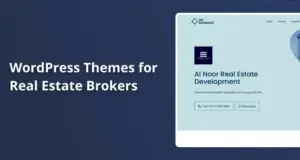Why Amazon Web Services for WordPress Real Estate Sites
Many real estate professionals run WordPress sites to list properties, share blog posts, and display contact forms. These websites can be small or extremely large, depending on the number of listings and the volume of user traffic.
Amazon Web Services (AWS) offers hosting solutions that fit both ends of the spectrum. A low-cost server might handle a small local agency’s website, while a cluster of load-balanced servers might fit a national property portal with thousands of listings.
AWS provides building blocks like Lightsail, EC2, RDS, S3, and others. Website owners can choose which elements matter most and assemble a setup that meets their current needs. The advantage is having room to grow without moving to a new provider.
Each AWS component fulfills a specific role for a WordPress real estate website. When arranged correctly, it can boost performance and stability.
AWS Essentials for WordPress Hosting
AWS offers many products, but a few stand out for WordPress. This list explains what each one does in simple terms:
- Lightsail:
- Simplified hosting with a single monthly price
- One-click WordPress setup
- Includes instance, storage, and a large data allowance
- EC2 (Elastic Compute Cloud):
- Virtual servers with broad customization
- You pick the CPU, memory, and operating system
- Suitable for flexible or larger-scale projects
- RDS (Relational Database Service):
- Managed database hosting (MySQL, MariaDB, or Aurora)
- Offloads typical database upkeep
- Scales well for busy websites
- S3 (Simple Storage Service):
- Object storage for images, PDFs, backups, and more
- Often paired with WordPress to store media files
- Pay for storage space used
- CloudFront:
- Global content delivery network (CDN)
- Delivers images, styles, or scripts from servers close to users
- Improves site speed and reduces load on the central server
- Route 53:
- DNS management service
- Points your domain name (e.g., yourrealtysite.com) to AWS resources
- Integrates easily with other AWS features
These services can be woven together in different ways. Some solutions rely on a single instance, while others spread the workload across many servers. WordPress hosting is not one-size-fits-all. It depends on how many people visit your site, how many listings you handle, and how important uptime is for your real estate business.
Reasons to Choose AWS for Real Estate Websites
The real estate field can be demanding on server resources because property listings often include images, advanced search features, and location data. AWS is helpful because:
- It offers a stable infrastructure that rarely experiences major outages
- You can pick from small or large server types
- You can combine specialized tools, like a managed database service, for heavy read/write operations
Some WordPress real estate sites begin with fewer than 50 listings. Others hold thousands of entries, user logins, and extra data from plugins like MLSimport. AWS supports this variety better than many single-tier hosting providers.
Scenario 1: Simple and Low-Cost for Smaller Sites
A small real estate website might only display basic property pages, contact details, and a few photos. This type of site could benefit from a straightforward setup. Two popular ways to do it on AWS are Lightsail or a single EC2 instance.
Lightsail One-Click WordPress
Lightsail provides a quick path for launching WordPress:
- Click a blueprint in Lightsail to start a WordPress instance
- Pay a fixed monthly amount (e.g., 5 USD for 1 GB RAM, 1 vCPU, 40 GB storage)
- Get a static IP address and include data transfer
This approach keeps everything on one virtual machine. If you have around 100 listings or fewer, the site content likely fits comfortably within 1 or 2 GB of RAM. Lightsail includes a firewall and a friendly console for managing DNS or upgrades.
Why Lightsail Can Be Great
- It’s a single monthly bill with few surprises
- Setup takes minutes, without deep AWS knowledge
- Perfect for smaller or mid-size real estate agencies with moderate traffic
Potential Downsides
- If traffic spikes, you must manually switch to a larger plan
- The machine is a single point of failure
- No built-in multi-server or auto-scaling features
Some site owners also keep backups of the entire instance. Lightsail supports snapshots, which are essential for real estate data. The bigger your site grows, the more valuable these snapshots become in case you need a rollback.
Single EC2 Instance Alternative
The same one-server concept is possible with EC2 instead of Lightsail. You pick an instance type, attach storage, and then install WordPress manually or via an Amazon Machine Image (AMI).
That approach allows more control of networking, security groups, and other AWS settings. However, paying for data transfer separately might be more expensive.
For a small site, many prefer Lightsail due to its more straightforward interface and included data allowance. EC2 is worthwhile if you need custom configurations and direct access to advanced features.
Scenario 2: Larger and Scalable for Thousands of Listings
A big real estate site might handle thousands of MLS entries, user logins, property photos, advanced search filters, and more. This volume can strain a single server, but AWS offers ways to split the WordPress setup into parts that can be scaled, cached, and made more reliable.
Core Multi-Tier Components
One recommended structure includes several layers:
- EC2 Auto Scaling Group
- More than one web server to serve pages
- Each server runs WordPress code and an HTTP server
- Auto-scaling can add or remove servers based on traffic
- Load Balancer
- Distributes visitor requests to the servers
- Check which server is healthy
- Simplifies having a single domain name entry point
- Managed Database (RDS or Aurora)
- Stores all WordPress data in a stable environment
- Handles large volumes of read/write operations
- Creates backups automatically
- Shared Storage or Object Storage
- EFS (Elastic File System) or S3 for media files
- Makes sure all servers deliver the same uploaded content
- Prevents file mismatches when multiple instances are running
- CloudFront CDN
- Speeds up media delivery worldwide
- Lowers load on the main servers
- Suitable for high-traffic real estate sites with many images
The database is often the bottleneck when a site grows, especially with property searches. The main server can focus on WordPress tasks by moving the database to RDS or Aurora. The load balancer passes new visits across servers, and the auto-scaling group can spin up extra servers as needed.
Key Benefits of a Multi-Tier Setup
- Higher Reliability: If one server fails, another is still available
- Better Load Handling: A cluster can handle more users at once
- Auto Scaling: The system reacts to changes in real-time
Potential Drawbacks
- Higher monthly bills (multiple servers, load balancer, managed DB)
- More complex to configure
- Requires more AWS knowledge or a dev team
Key Components in Detail
WordPress does not need every AWS service all at once. Many large sites add them step by step. Here are some important ones:
RDS (Relational Database Service)
AWS RDS hosts MySQL, MariaDB, or Aurora. WordPress can connect to it as the central database instead of using a local MySQL install. This helps because:
- AWS handles routine updates and patches
- You can scale the database if the site grows
- Is it possible to add replicas for read-heavy queries
A busy real estate website with thousands of listings and daily searches might benefit from Aurora. It’s a MySQL-compatible engine that can process large volumes quickly. A typical approach would be:
- A primary DB instance that handles writes
- One or more read replicas that serve read queries to reduce the load on the primary
ElastiCache
ElastiCache provides a managed Redis or Memcached service. WordPress is known to benefit from caching. If you have a plugin that supports Redis, it can store common queries or session data in memory, speeding up search results or page loads. Some queries might happen repeatedly for a site with thousands of listings, so caching them can save time.
Storage: EFS vs. S3
A multi-server setup needs consistent handling of file uploads. If one server gets a new image, the others must display it, too. Two common methods:
- EFS:
- In a network-based drive, all servers can read and write
- Feels like a shared folder mounted on each server
- Can store WordPress plugins, media, or theme files
- S3:
- Object storage for images or static files
- Often used with a WordPress plugin that offloads media to S3
- Works well with CloudFront for global content delivery
S3 is quite popular because it offers strong reliability and reduces the size of what each server must hold. EFS is helpful when you want an actual shared filesystem. Some advanced sites use a hybrid approach: WordPress code in a repository or AMI, user uploads in S3, and caching at CloudFront.

Cost Discussion
AWS can be cost-friendly or pricey, based on which services you use and how large they are. A small Lightsail instance might cost around 5 USD monthly, while a multi-tier environment can cost hundreds. Below are broad ideas of what to expect:
- Lightsail Single Instance
- 5 to 10 USD per month for 1 or 2 GB of RAM
- Includes SSD storage and large data limits
- Perfect for small traffic
- EC2 + RDS
- The web server might cost 15 to 25 USD monthly if it runs all-day
- The database might be another 13 to 50 USD monthly or more, depending on size
- Data transfer is extra, sometimes around 0.09 USD per GB after the free tier
- Multi-Tier with Auto Scaling
- It may require at least two EC2 servers to keep things redundant
- A load balancer has a base charge plus small usage fees
- Managed database with Multi-AZ might be 200 to 300 USD monthly or more
- A caching layer might add 30 USD monthly if you run a small ElastiCache node
- S3 and CloudFront costs depend on how many images and how much data goes out each month
The total can climb to hundreds of dollars if you need advanced features. This is more than basic shared hosting; the trade-off is top performance and room to expand.
Many large real estate sites invest in robust solutions for busy periods or big import jobs.
AWS’s pricing can be lowered with reserved instances or savings plans, which let you commit for a year or more in exchange for a discount. Another way to reduce data transfer is by having CloudFront deliver your images because CloudFront can be cheaper than raw EC2 data transfer.
Maintenance and Backups
Even with managed services, you need a plan for updates, security patches, and backups. AWS does not patch your WordPress site for you, though RDS will fix the database engine.
Common Tasks
- Update WordPress core, themes, and plugins regularly
- Keep backups of your instance or your database (like RDS snapshots)
- Monitor performance metrics using AWS CloudWatch
Helpful Points
- Lightsail snapshots let you revert to a stable state
- RDS can generate automated backups, but you decide how long to keep them
- S3 is often used for storing backups (manual or automatic)
Periodic checks on CPU, RAM, and disk usage keep you from running out of resources. Real estate sites might experience growth in listing photos or property data. If you ignore that for too long, you can hit performance roadblocks.
Real Estate Themes and Plugins on AWS
Many real estate sites use WordPress themes like WpResidence. They might also need an MLS / IDX listing feed plugin like MLSimport. These can work well on AWS, though it’s wise to note a few aspects:
- Imports: Bulk import processes can use a lot of database resources. To reduce slowdowns, you might want a larger instance or a separate database server.
- Images: Property photos can quickly fill storage. Offloading them to S3 or using CloudFront can make the site load faster and avoid big server disks.
- PHP Settings: Some real estate plugins need a higher max_input_vars or memory limit. Adjusting these in your PHP configuration is easy on a Lightsail or EC2 instance, but remember to do it.
WordPress real estate sites also rely on stable uptime because potential buyers or renters might visit at random times. A glitchy site can deter leads. This is why a multi-tier approach might pay off if you run a business that depends on continuous online presence.
Where Each Option Fits Best
It helps to match the hosting architecture to your traffic level and property count:
- Lightsail Single Instance
- Good for fewer than 100 listings and mild traffic
- Can handle a moderate number of images or visitors
- Simple to manage, with snapshots for backups
- One EC2 + RDS
- It is best if you suspect future growth but don’t need many servers yet
- It helps split the database from the web layer
- It is slightly higher cost than Lightsail, but it is more flexible
- Full Multi-Tier Setup
- Ideal for sites with thousands of listings, frequent updates, or large user traffic
- Multiple servers managed database, caching, and load balancing
- It costs more each month but offers strong performance and reliability
Many site owners start small and expand if the site gets more traffic or listings. AWS is pay-as-you-go, so you can upgrade an instance or add a service as needed.
Common Pitfalls to Avoid
AWS is powerful but can be confusing. Some real estate site owners make mistakes that lead to problems:
- Over-Provisioning: Buying a huge instance or entire multi-server stack when the site is tiny. This wastes money.
- Under-Provisioning: Running everything on a tiny instance, then facing crashes once traffic surges or database size grows.
- Ignoring Backups: A single disk snapshot from three months ago might not be enough. A schedule that saves daily or weekly backups is better.
- Skipping Updates: WordPress core, themes, and plugins need attention. If you let them go stale, security holes will appear.
Bullet Points for Safer AWS Use
- Start with a plan that fits your real estate site’s accurate scale
- Set up reminders for WordPress updates and snapshots
- Keep track of monthly bills, so you see any sudden jumps
AWS can host a WordPress real estate site at almost any size. A compact Lightsail setup might be all you need if your listings are few and your traffic is moderate. A more complex multi-tier architecture could easily handle massive import jobs, major traffic spikes, and advanced search features.
The WpResidence theme and MLSimport plugin run smoothly on these AWS setups as long as you meet basic system requirements.
It is wise to pick a hosting style that matches your budget and growth plans. You can begin with a single instance for around 5 USD per month, then move toward an EC2 plus RDS approach once traffic rises. You can keep scaling until you have multiple servers, a managed database, caching layers, and a load balancer. This level of expansion can handle thousands of visitors and big sets of property data.









